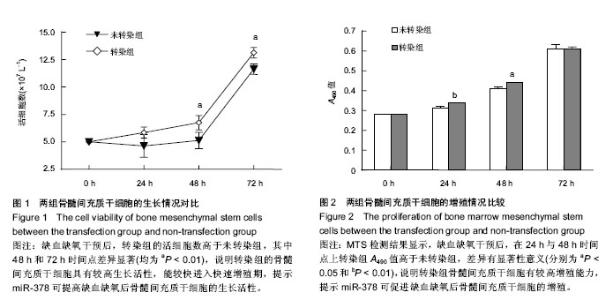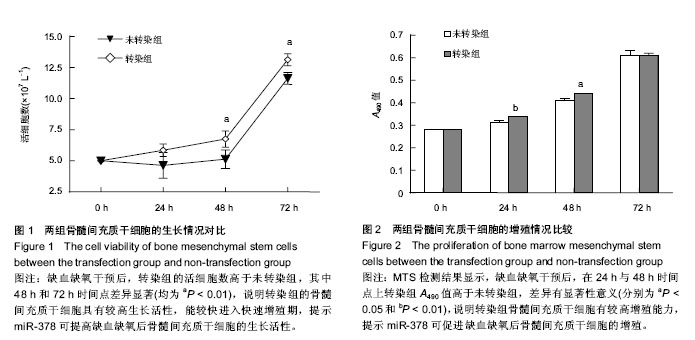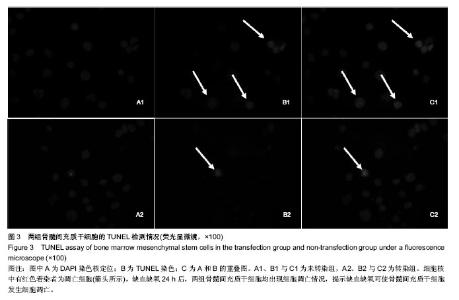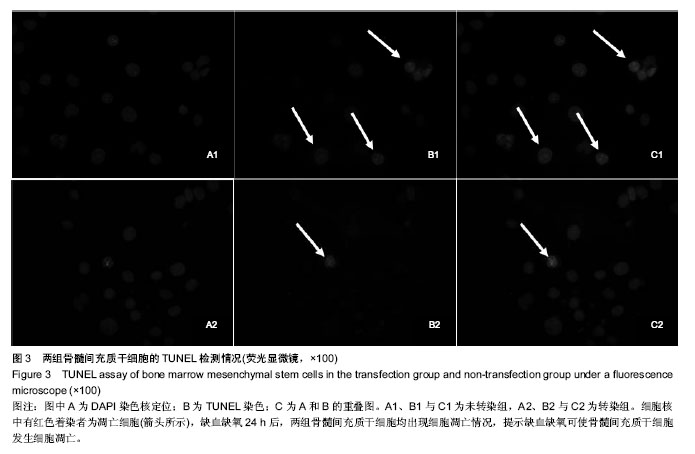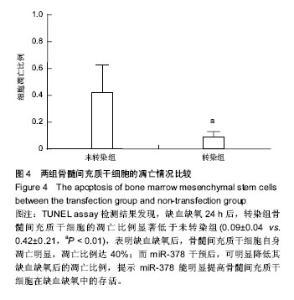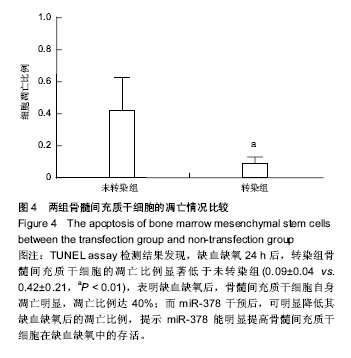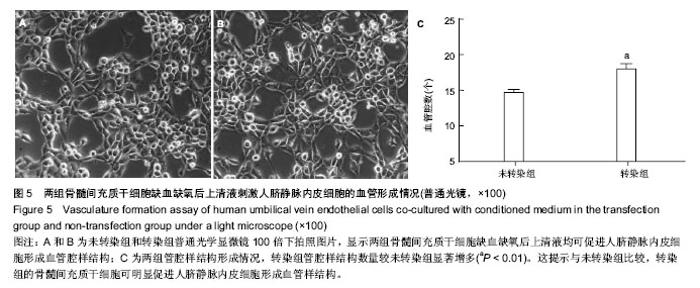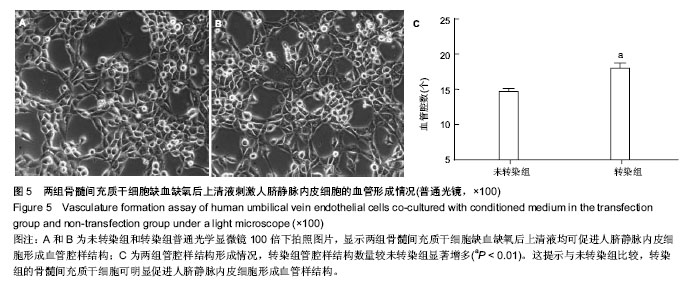Chinese Journal of Tissue Engineering Research ›› 2014, Vol. 18 ›› Issue (19): 2961-2967.doi: 10.3969/j.issn.2095-4344.2014.19.002
Previous Articles Next Articles
miR-378 effects on the proliferation and apoptosis of bone marrow mesenchymal stem cells under hypoxic-ischemic condition
Guo Tian-zhu, Xing Yue, Hou Jing-ying, Zhou Chang-qing, Zhong Ting-ting, Zheng Shao-xin, Wang Tong
- Department of Emergency, Sun Yat-sen Memorial Hospital, Sun Yat-sen University, Guangzhou 510120, Guangdong Province, China
-
Revised:2014-04-04Online:2014-05-07Published:2014-05-07 -
Contact:Wang Tong, M.D., Professor, Chief physician, Investigator, Doctoral supervisor, Department of Emergency, Sun Yat-sen Memorial Hospital, Sun Yat-sen University, Guangzhou 510120, Guangdong Province, China -
About author:Guo Tian-zhu, Studying for master’s degree, Department of Emergency, Sun Yat-sen Memorial Hospital, Sun Yat-sen University, Guangzhou 510120, Guangdong Province, China -
Supported by:the National Natural Science Foundation of China, No. 81070125, 81270213; the Scientific and Technological Plan of Guangdong Province, No. 2010B031600032; the Fundamental Research Funds for Universities-Key Cultivation Project of Young Teachers in Sun Yat-sen University, No. 13ykzd16
CLC Number:
Cite this article
Guo Tian-zhu, Xing Yue, Hou Jing-ying, Zhou Chang-qing, Zhong Ting-ting, Zheng Shao-xin, Wang Tong . miR-378 effects on the proliferation and apoptosis of bone marrow mesenchymal stem cells under hypoxic-ischemic condition[J]. Chinese Journal of Tissue Engineering Research, 2014, 18(19): 2961-2967.
share this article
| [1] World Health Organization.Global status report on noncommunicable disaeses 2010. Geneva, World Health Organization, 2011. [2] World Health Organization.Global atlas on cardiovascular disease prevention and control. Geneva, World Health Organization, 2011. [3] 卫生部心血管病防治研究中心. 中国心血管病报告2011[M]. 北京:中国大百科全书出版社, 2011. [4] Pittenger MF, Martin BJ.Mesenchymal stem cells and their potential as cardiac therapeutics.Circ Res. 2004;95(1):9-20. [5] Dai W, Hale SL, Martin BJ,et al.Allogeneic mesenchymal stem cell transplantation in postinfarcted rat myocardium: short-and long-term effects.Circulation. 2005;112(2): 214-223. [6] Wang T, Tang W, Sun S,et al.Intravenous infusion of bone marrow mesenchymal stem cells improves myocardial function in a rat model of myocardial ischemia.Crit Care Med. 2007;35(11):2587-2593. [7] Wang T, Tang W, Sun S,et al.Mesenchymal stem cells improve outcomes of cardiopulmonary resuscitation in myocardial infarcted rats.J Mol Cell Cardiol. 2009;46(3): 378-384. [8] van der Bogt KE, Sheikh AY, Schrepfer S,et al.Comparison of different adult stem cell types for treatment of myocardial ischemia.Circulation. 2008;118(14 Suppl):S121-129. [9] Chen SL, Fang WW, Ye F,et al.Effect on left ventricular function of intracoronary transplantation of autologous bone marrow mesenchymal stem cell in patients with acute myocardial infarction.Am J Cardiol. 2004;94(1):92-95. [10] Mohyeddin-Bonab M, Mohamad-Hassani MR, Alimoghaddam K,et al.Autologous in vitro expanded mesenchymal stem cell therapy for human old myocardial infarction.Arch Iran Med. 2007;10(4):467-473. [11] Hare JM, Traverse JH, Henry TD,et al.A randomized, double-blind, placebo-controlled, dose-escalation study of intravenous adult human mesenchymal stem cells (prochymal) after acute myocardial infarction.J Am Coll Cardiol. 2009; 54(24): 2277-2286. [12] Williams AR, Trachtenberg B, Velazquez DL,et al. Intramyocardial stem cell injection in patients with ischemic cardiomyopathy: functional recovery and reverse remodeling. Circ Res. 2011;108(7):792-796. [13] Trachtenberg B, Velazquez DL, Williams AR,et al.Rationale and design of the Transendocardial Injection of Autologous Human Cells (bone marrow or mesenchymal) in Chronic Ischemic Left Ventricular Dysfunction and Heart Failure Secondary to Myocardial Infarction (TAC-HFT) trial: A randomized, double-blind, placebo-controlled study of safety and efficacy.Am Heart J. 2011;161(3):487-493. [14] Wen Z, Zheng S, Zhou C,et al.Repair mechanisms of bone marrow mesenchymal stem cells in myocardial infarction.J Cell Mol Med. 2011;15(5):1032-1043. [15] Abdel-Latif A, Bolli R, Tleyjeh IM,et al.Adult bone marrow-derived cells for cardiac repair: a systematic review and meta-analysis.Arch Intern Med. 2007;167(10):989-997. [16] Zhu W, Chen J, Cong X, et al.Hypoxia and serum deprivation-induced apoptosis in mesenchymal stem cells.Stem Cells. 2006;24(2):416-425. [17] Saini U, Gumina RJ, Wolfe B,et al.Preconditioning mesenchymal stem cells with caspase inhibition and hyperoxia prior to hypoxia exposure increases cell proliferation.J Cell Biochem. 2013;114(11):2612-2623. [18] Chavakis E, Koyanagi M, Dimmeler S.Enhancing the outcome of cell therapy for cardiac repair: progress from bench to bedside and back.Circulation. 2010;121(2):325-335. [19] Huang XP, Sun Z, Miyagi Y,et al. Differentiation of allogeneic mesenchymal stem cells induces immunogenicity and limits their long-term benefits for myocardial repair.Circulation. 2010; 122(23):2419-2429. [20] Wen Z, Zheng S, Zhou C,et al.Bone marrow mesenchymal stem cells for post-myocardial infarction cardiac repair: microRNAs as novel regulators.J Cell Mol Med. 2012;16(4): 657-671. [21] Urbich C, Kuehbacher A, Dimmeler S.Role of microRNAs in vascular diseases, inflammation, and angiogenesis. Cardiovasc Res. 2008;79(4):581-588. [22] Matkovich SJ, Hu Y, Dorn GW 2nd. Regulation of cardiac microRNAs by cardiac microRNAs.Circ Res. 2013;113(1): 62-71. [23] Naga Prasad SV, Duan ZH, Gupta MK,et al.Unique microRNA profile in end-stage heart failure indicates alterations in specific cardiovascular signaling networks.J Biol Chem. 2009; 284(40):27487-27499. [24] Lee DY, Deng Z, Wang CH,et al.MicroRNA-378 promotes cell survival, tumor growth, and angiogenesis by targeting SuFu and Fus-1 expression.Proc Natl Acad Sci U S A. 2007; 104 (51): 20350-20355. [25] Chen LT, Xu SD, Xu H,et al.MicroRNA-378 is associated with non-small cell lung cancer brain metastasis by promoting cell migration, invasion and tumor angiogenesis.Med Oncol. 2012; 29(3):1673-1680. [26] Amsalem Y, Mardor Y, Feinberg MS,et al.Iron-oxide labeling and outcome of transplanted mesenchymal stem cells in the infarcted myocardium.Circulation. 2007;116(11 Suppl):I38-45. [27] 孔宏亮,刘宁宁,霍鑫,等. 缺氧对大鼠骨髓间充质干细胞增殖、凋亡及葡萄糖摄取和Akt表达的影响[J].中国现代医学杂志, 2008, 18(10): 1374-1378,1382. [28] 徐巧岩,夏琳,王吉昌.低氧预处理骨髓间充质干细胞耐受缺血缺氧的能力[J].中国组织工程研究, 2013, 17(49): 8474-8480. [29] Cao W, Guo XW, Chen K,et al.Inhibition of hypoxia and serum deprivation-induced apoptosis by salvianolic acid in rat mesenchymal stem cells.J Tradit Chin Med. 2012;32(2): 222-228. [30] Xie X, Sun A, Zhu W,et al.Transplantation of mesenchymal stem cells preconditioned with hydrogen sulfide enhances repair of myocardial infarction in rats.Tohoku J Exp Med. 2012; 226(1):29-36. [31] McGinley L, McMahon J, Strappe P,et al.Lentiviral vector mediated modification of mesenchymal stem cells & enhanced survival in an in vitro model of ischaemia.Stem Cell Res Ther. 2011;2(2):12. [32] Tsubokawa T, Yagi K, Nakanishi C,et al.Impact of anti-apoptotic and anti-oxidative effects of bone marrow mesenchymal stem cells with transient overexpression of heme oxygenase-1 on myocardial ischemia.Am J Physiol Heart Circ Physiol. 2010;298(5):H1320-1329. [33] Yu B, Gong M, He Z,et al.Enhanced mesenchymal stem cell survival induced by GATA-4 overexpression is partially mediated by regulation of the miR-15 family.Int J Biochem Cell Biol. 2013;45(12):2724-2735. [34] Eichner LJ, Perry MC, Dufour CR,et al.miR-378(∗) mediates metabolic shift in breast cancer cells via the PGC-1β/ERRγ transcriptional pathway.Cell Metab. 2010;12(4):352-361. [35] Deng H, Guo Y, Song H,et al.MicroRNA-195 and microRNA-378 mediate tumor growth suppression by epigenetical regulation in gastric cancer.Gene. 2013;518(2): 351-359. [36] Fang J, Song XW, Tian J,et al.Overexpression of microRNA-378 attenuates ischemia-induced apoptosis by inhibiting caspase-3 expression in cardiac myocytes. Apoptosis. 2012;17(4):410-423. [37] Knezevic I, Patel A, Sundaresan NR,et al. A novel cardiomyocyte-enriched microRNA, miR-378, targets insulin-like growth factor 1 receptor: implications in postnatal cardiac remodeling and cell survival.J Biol Chem. 2012;287 (16): 12913-12926. [38] Kim SW, Kim HW, Huang W,et al.Cardiac stem cells with electrical stimulation improve ischaemic heart function through regulation of connective tissue growth factor and miR-378.Cardiovasc Res. 2013;100(2):241-251. [39] Bonauer A, Boon RA, Dimmeler S.Vascular microRNAs.Curr Drug Targets. 2010;11(8):943-949. [40] Skrzypek K, Tertil M, Golda S,et al.Interplay between heme oxygenase-1 and miR-378 affects non-small cell lung carcinoma growth, vascularization, and metastasis.Antioxid Redox Signal. 2013;19(7):644-660. |
| [1] | Pu Rui, Chen Ziyang, Yuan Lingyan. Characteristics and effects of exosomes from different cell sources in cardioprotection [J]. Chinese Journal of Tissue Engineering Research, 2021, 25(在线): 1-. |
| [2] | Lin Qingfan, Xie Yixin, Chen Wanqing, Ye Zhenzhong, Chen Youfang. Human placenta-derived mesenchymal stem cell conditioned medium can upregulate BeWo cell viability and zonula occludens expression under hypoxia [J]. Chinese Journal of Tissue Engineering Research, 2021, 25(在线): 4970-4975. |
| [3] | Geng Qiudong, Ge Haiya, Wang Heming, Li Nan. Role and mechanism of Guilu Erxianjiao in treatment of osteoarthritis based on network pharmacology [J]. Chinese Journal of Tissue Engineering Research, 2021, 25(8): 1229-1236. |
| [4] | Liu Cong, Liu Su. Molecular mechanism of miR-17-5p regulation of hypoxia inducible factor-1α mediated adipocyte differentiation and angiogenesis [J]. Chinese Journal of Tissue Engineering Research, 2021, 25(7): 1069-1074. |
| [5] | Wang Xianyao, Guan Yalin, Liu Zhongshan. Strategies for improving the therapeutic efficacy of mesenchymal stem cells in the treatment of nonhealing wounds [J]. Chinese Journal of Tissue Engineering Research, 2021, 25(7): 1081-1087. |
| [6] | Wang Shiqi, Zhang Jinsheng. Effects of Chinese medicine on proliferation, differentiation and aging of bone marrow mesenchymal stem cells regulating ischemia-hypoxia microenvironment [J]. Chinese Journal of Tissue Engineering Research, 2021, 25(7): 1129-1134. |
| [7] | Kong Desheng, He Jingjing, Feng Baofeng, Guo Ruiyun, Asiamah Ernest Amponsah, Lü Fei, Zhang Shuhan, Zhang Xiaolin, Ma Jun, Cui Huixian. Efficacy of mesenchymal stem cells in the spinal cord injury of large animal models: a meta-analysis [J]. Chinese Journal of Tissue Engineering Research, 2021, 25(7): 1142-1148. |
| [8] | Hou Jingying, Yu Menglei, Guo Tianzhu, Long Huibao, Wu Hao. Hypoxia preconditioning promotes bone marrow mesenchymal stem cells survival and vascularization through the activation of HIF-1α/MALAT1/VEGFA pathway [J]. Chinese Journal of Tissue Engineering Research, 2021, 25(7): 985-990. |
| [9] | Shi Yangyang, Qin Yingfei, Wu Fuling, He Xiao, Zhang Xuejing. Pretreatment of placental mesenchymal stem cells to prevent bronchiolitis in mice [J]. Chinese Journal of Tissue Engineering Research, 2021, 25(7): 991-995. |
| [10] | Liang Xueqi, Guo Lijiao, Chen Hejie, Wu Jie, Sun Yaqi, Xing Zhikun, Zou Hailiang, Chen Xueling, Wu Xiangwei. Alveolar echinococcosis protoscolices inhibits the differentiation of bone marrow mesenchymal stem cells into fibroblasts [J]. Chinese Journal of Tissue Engineering Research, 2021, 25(7): 996-1001. |
| [11] | Fan Quanbao, Luo Huina, Wang Bingyun, Chen Shengfeng, Cui Lianxu, Jiang Wenkang, Zhao Mingming, Wang Jingjing, Luo Dongzhang, Chen Zhisheng, Bai Yinshan, Liu Canying, Zhang Hui. Biological characteristics of canine adipose-derived mesenchymal stem cells cultured in hypoxia [J]. Chinese Journal of Tissue Engineering Research, 2021, 25(7): 1002-1007. |
| [12] | Geng Yao, Yin Zhiliang, Li Xingping, Xiao Dongqin, Hou Weiguang. Role of hsa-miRNA-223-3p in regulating osteogenic differentiation of human bone marrow mesenchymal stem cells [J]. Chinese Journal of Tissue Engineering Research, 2021, 25(7): 1008-1013. |
| [13] | Lun Zhigang, Jin Jing, Wang Tianyan, Li Aimin. Effect of peroxiredoxin 6 on proliferation and differentiation of bone marrow mesenchymal stem cells into neural lineage in vitro [J]. Chinese Journal of Tissue Engineering Research, 2021, 25(7): 1014-1018. |
| [14] | Zhu Xuefen, Huang Cheng, Ding Jian, Dai Yongping, Liu Yuanbing, Le Lixiang, Wang Liangliang, Yang Jiandong. Mechanism of bone marrow mesenchymal stem cells differentiation into functional neurons induced by glial cell line derived neurotrophic factor [J]. Chinese Journal of Tissue Engineering Research, 2021, 25(7): 1019-1025. |
| [15] | Duan Liyun, Cao Xiaocang. Human placenta mesenchymal stem cells-derived extracellular vesicles regulate collagen deposition in intestinal mucosa of mice with colitis [J]. Chinese Journal of Tissue Engineering Research, 2021, 25(7): 1026-1031. |
| Viewed | ||||||
|
Full text |
|
|||||
|
Abstract |
|
|||||
